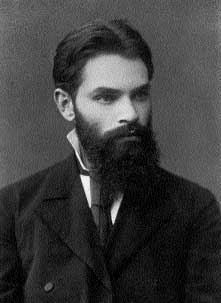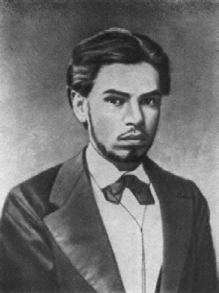<Back to Index>
- Mathematician Aleksandr Mikhailovich Lyapunov, 1857
- Dramatist Pierre Corneille, 1606
- Duke of Xinguo Wen Tianxiang, 1236
PAGE SPONSOR


Aleksandr Mikhailovich Lyapunov (Russian: Александр Михайлович Ляпунов; June 6 [O.S. May 25] 1857 – November 3, 1918) was a Russian mathematician, mechanician and physicist. His surname is sometimes romanized as Ljapunov, Liapunov or Ljapunow. Lyapunov is known for his development of the stability theory of a dynamical system, as well as for his many contributions to mathematical physics and probability theory.
Lyapunov was born in Yaroslavl, Russian Empire. His father Mikhail Vasilyevich Lyapunov (1820 – 1868) was an astronomer and a head of the Demidovski lyceum.
In 1863, M.V. Lyapunov retired from his scientific career and
relocated his family to his wife's estate at Bolobonov, in the Simbirsk
province (now Ulyanovsk Oblast). After the death of his father in 1868, Aleksandr Lyapunov was educated by his uncle R.M. Sechenov, brother of the famous physiologist Ivan Mikhailovich Sechenov.
At his uncle's family, Lyapunov studied with his distant cousin Natalia
Rafailovna, who became his wife in 1886. In 1870, his mother moved with
her sons to Nizhny Novgorod, where he started the third class of the gymnasium. He graduated from the gymnasium with distinction in 1876. In 1876 Lyapunov entered the Physico-Mathematical faculty of the University of Saint Petersburg,
but after one month he transferred to the Mathematics department of the
university. Among the Saint Petersburg professors of mathematics were Chebyshev and his students Aleksandr Nikolaevich Korkin and Yegor Ivanovich Zolotarev.
Lyapunov wrote his first independent scientific works under the
guidance of the professor of mechanics, D.K. Bobylev. In 1880 Lyapunov
received a gold medal for a work on hydrostatics. This was the basis for his first published scientific works On the equilibrium of a heavy body in a heavy fluid contained in a vessel of a fixed form and On the potential of hydrostatic pressure. Lyapunov completed his university course in 1880, two years after Andrey Markov who
had also graduated at Saint Petersburg University. Lyapunov would
maintain a scientific contact with Markov during all his life. In 1884 Lyapunov defended his Master's thesis On the stability of ellipsoidal forms of equilibrium of rotating fluids. This theme was suggested to him by Chebyshev, who had already suggested it to other students of his, such as Zolotarev and Sofia Vasilyevna Kovalevskaya. The thesis was publicized in 1885 in the Bulletin Astronomique. It was fully translated in French in 1904 and attracted the attention of mathematicians, physicists and astronomers in Europe. In 1895 Lyapunov became privatdozent and was proposed to accept the chair of mechanics at Kharkiv University, where he went the same year. About the initial stay at Kharkiv, Lyapunov writes in his autobiography: His student and collaborator, Vladimir Steklov,
recalled his first lecture in the following way: "A handsome
young man, almost of the age of the other students, came before the
audience, where there was also the old Dean, professor Levakovsky, who
was respected by all students. After the Dean had left, the young man
with a trembled voice started to lecture a course on the dynamics of
material points, instead of a course on dynamical systems.
This subject was already known to the students from the lectures of
professor Delarue. But what Lyapunov taught us was new to me and I had
never seen this material in any textbook. All antipathy to the course
was immediately blown to dust. From that day students would show
Lyapunov a special respect." In 1892 Lyapunov defended his famous doctoral thesis The general problem of the stability of motion. The thesis was defended in Moscow University on September 12, 1892, with Nikolai Zhukovsky and
V.B. Mlodzeevski as opponents. This dissertation was, as with the
master's, also translated into French. The next year Lyapunov became a
full professor at Kharkiv University. Lyapunov
returned to Saint Petersburg in 1902, after being elected acting member
of the Academy of Science as well as ordinary professor in the Faculty
of Applied Mathematics of the university. The position had been left
vacant by the death of his former teacher, Chebyshev. Not having any
teaching obligations, this allowed Lyapunov to focus on his studies and
in particular he was able to bring to a conclusion the work on the
problem of Chebyshev with which he started his scientific career. In 1908 he took part to the Fourth International Mathematical Congress in Rome. He also participated in the publication of Euler's selected works: he was an editor of the volumes 18 and 19. By
the end of June 1917, Lyapunov traveled with his wife to his brother's
place in Odessa. Lyapunov's wife was suffering from tuberculosis so
they moved following her doctor's orders. She died on October 31, 1918.
The same day, Lyapunov shot himself in the head, and three days later
he died. Lyapunov contributed to several fields, including differential equations, potential theory, dynamical systems and probability theory.
His main preoccupations were the stability of equilibria and the motion
of mechanical systems, the model theory for the stability of uniform
turbulent liquid, and the study of particles under the influence of
gravity. His work in the field of mathematical physics regarded the boundary value problem of the equation of Laplace. In the theory of potential, his work from 1897 On some questions connected with Dirichlet's problem clarified
several important aspects of the theory. His work in this field is in
close connection with the work of Steklov. Lyapunov developed many
important approximation methods. His methods, which he developed in
1899, make it possible to define the stability of sets of ordinary
differential equations. He created the modern theory of the stability
of a dynamic system. In the theory of probability, he generalised the
works of Chebyshev and Markov, and proved the Central Limit Theorem under
more general conditions than his predecessors. The method he used for
the proof found later widespread use in probability theory. Like
many mathematicians, Lyapunov preferred to work alone and communicated
mainly with few colleagues and close relatives. He usually worked late,
four to five hours at night, sometimes the whole night. Once or twice a
year he visited the theatre, or went to some concert. He had many
students. He was an honorary member of many universities, an honorary
member of the Academy in Rome and a corresponding member of the Academy of Sciences in Paris.